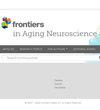Association between frailty index and cognitive dysfunction in older adults: insights from the 2011–2014 NHANES data
IF 4.1
2区 医学
Q2 GERIATRICS & GERONTOLOGY
引用次数: 0
Abstract
BackgroundAs the population ages, the occurrence of cognitive decline and dementia is continuously increasing. Frailty is a prevalent problem among older adults. Epidemiologic studies have shown a comorbidity between frailty and cognitive impairment. However, their relationship remains unclear. The frailty index is an important indicator for measuring frailty. This study aims to investigate the relationship between frailty index and cognitive dysfunction in older adults aged 60 years and older in the United States from the 2011–2014 National Health and Nutrition Examination Survey (NHANES).MethodsCommunity-dwelling older adults aged 60 years or older from 2011 to 2014 were extracted from the NHANES database. The frailty index was calculated using the formula: frailty index = total number of deficits present/total number of deficits measured. The Animal Fluency (AF), the Digit Symbol Substitution Test (DSST), the Consortium to Establish a Registry for Alzheimer’s disease Delayed Recall (CERAD-DR), and Word Learning (CERAD-WL) were used to evaluate cognitive dysfunction. Firstly, weighted logistic regression analysis was used to explore the relationship between frailty index and cognitive dysfunction. Secondly, the influence of covariates on the frailty index was evaluated by subgroup analysis and interaction. Finally, the non-linear relationship is discussed by using the restricted cubic spline regression model.ResultsOur study included a total of 2,574 patients, weighted logistic regression analysis, after adjusting for all covariates, showed that the frailty index was associated with every test score. The interaction showed that covariates had no significant effect on this association in AF. The association between the frailty index and AF in the restricted cubic spline regression model is non-linear. As the frailty index increased, the risk of AF reduction increased, suggesting a higher risk of cognitive dysfunction.ConclusionIn general, a high frailty index appears to be associated with an increased risk of cognitive dysfunction in the elderly. Consequently, protecting against cognitive decline necessitates making geriatric frailty prevention and treatment top priorities.老年人虚弱指数与认知功能障碍之间的关系:从 2011-2014 年 NHANES 数据中获得的启示
背景随着人口老龄化,认知能力下降和痴呆症的发生率不断上升。虚弱是老年人中普遍存在的问题。流行病学研究表明,虚弱与认知障碍之间存在共病关系。然而,它们之间的关系仍不明确。虚弱指数是衡量虚弱程度的一个重要指标。本研究旨在调查美国 2011-2014 年全国健康与营养调查(NHANES)中 60 岁及以上老年人的虚弱指数与认知功能障碍之间的关系。虚弱指数的计算公式为:虚弱指数 = 存在的缺陷总数/测量的缺陷总数。评估认知功能障碍的方法包括动物流畅度(AF)、数字符号替换测试(DSST)、建立阿尔茨海默病延迟回忆登记联盟(CERAD-DR)和单词学习(CERAD-WL)。首先,采用加权逻辑回归分析探讨虚弱指数与认知功能障碍之间的关系。其次,通过亚组分析和交互作用来评估协变量对虚弱指数的影响。结果我们的研究共纳入了 2,574 名患者,在对所有协变量进行调整后,加权逻辑回归分析表明,虚弱指数与每项测试评分都有关联。交互作用表明,协变量对房颤患者的这种关联没有显著影响。在限制性三次样条回归模型中,虚弱指数与房颤之间的关系是非线性的。随着虚弱指数的增加,房颤发生率降低的风险也随之增加,这表明认知功能障碍的风险更高。因此,要防止认知功能衰退,就必须将老年虚弱预防和治疗作为重中之重。
本文章由计算机程序翻译,如有差异,请以英文原文为准。
求助全文
约1分钟内获得全文
求助全文
来源期刊

Frontiers in Aging Neuroscience
GERIATRICS & GERONTOLOGY-NEUROSCIENCES
CiteScore
6.30
自引率
8.30%
发文量
1426
期刊介绍:
Frontiers in Aging Neuroscience is a leading journal in its field, publishing rigorously peer-reviewed research that advances our understanding of the mechanisms of Central Nervous System aging and age-related neural diseases. Specialty Chief Editor Thomas Wisniewski at the New York University School of Medicine is supported by an outstanding Editorial Board of international researchers. This multidisciplinary open-access journal is at the forefront of disseminating and communicating scientific knowledge and impactful discoveries to researchers, academics, clinicians and the public worldwide.
 求助内容:
求助内容: 应助结果提醒方式:
应助结果提醒方式:


